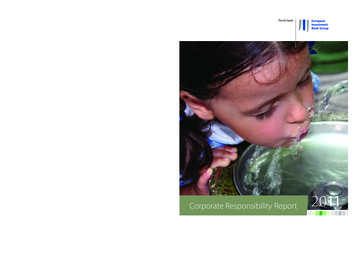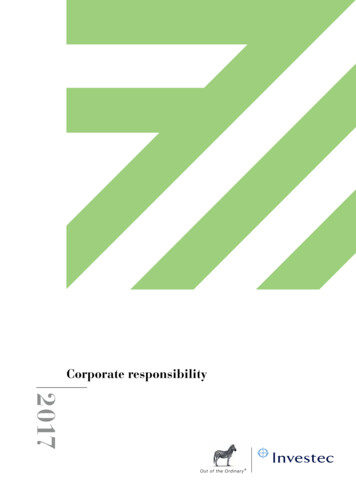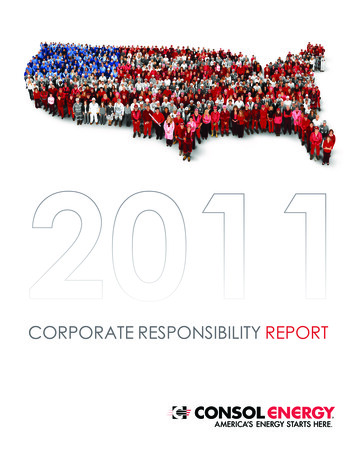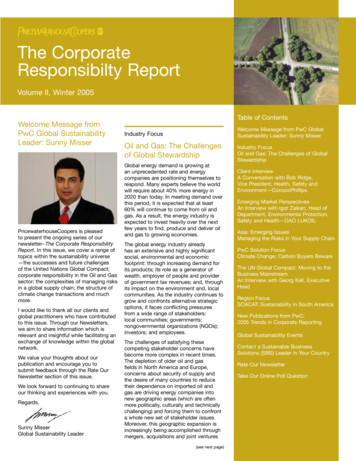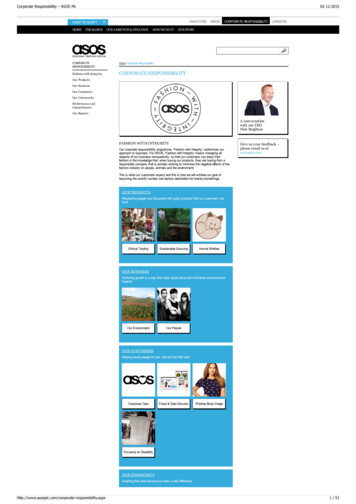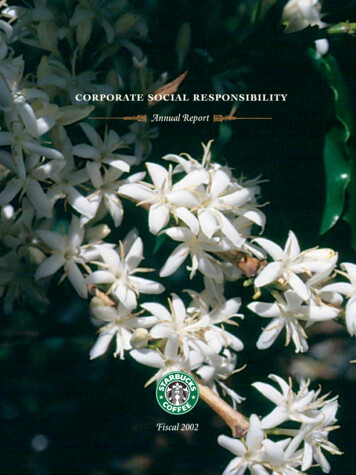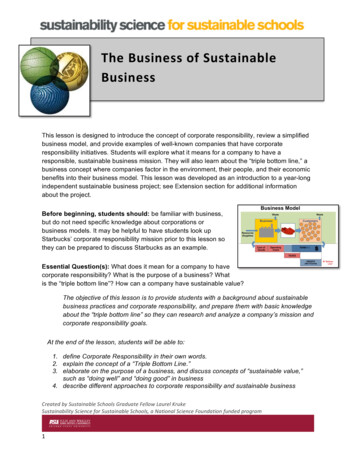
Transcription
TheB usinesso fS ustainableBusinessThis lesson is designed to introduce the concept of corporate responsibility, review a simplifiedbusiness model, and provide examples of well-known companies that have corporateresponsibility initiatives. Students will explore what it means for a company to have aresponsible, sustainable business mission. They will also learn about the “triple bottom line,” abusiness concept where companies factor in the environment, their people, and their economicbenefits into their business model. This lesson was developed as an introduction to a year-longindependent sustainable business project; see Extension section for additional informationabout the project.Before beginning, students should: be familiar with business,but do not need specific knowledge about corporations orbusiness models. It may be helpful to have students look upStarbucks’ corporate responsibility mission prior to this lesson sothey can be prepared to discuss Starbucks as an example.Essential Question(s): What does it mean for a company to havecorporate responsibility? What is the purpose of a business? Whatis the “triple bottom line”? How can a company have sustainable value?The objective of this lesson is to provide students with a background about sustainablebusiness practices and corporate responsibility, and prepare them with basic knowledgeabout the “triple bottom line” so they can research and analyze a company’s mission andcorporate responsibility goals.At the end of the lesson, students will be able to:1. define Corporate Responsibility in their own words.2. explain the concept of a “Triple Bottom Line.”3. elaborate on the purpose of a business, and discuss concepts of “sustainable value,”such as “doing well” and “doing good” in business4. describe different approaches to corporate responsibility and sustainable ls,aNationalScienceFoundationfundedprogram1
Standards Addressed:Next Generation Science Standards: HS Human Sustainability, Earth and Human Activity:HS-ESS3-4; HS Engineering Design: HS-ETS1-3.Business Management and Administrative Services (52.0200.00): 4.0 – DemonstrateGeneral Management Practices: 4.7 – Assess how a business’ responsibility to employees,shareholders, society, and the environment affects business decisions.Common Core and 21st Century Skills: Environmental Literacy; Creativity and Innovation;Critical Thinking and Problem SolvingThemes: Systems thinking, trade-offs, transdisciplinaritySkills: Problem-solving skills, evidence-based thinkingKey VocabularyBottom Line: financial profits or losses for a company (usually calculated after consideringsales figures, capital costs, and other expenses.Business: organizations that are involved in producing, or trading, goods and services toconsumers; usually used as a broader term to describe a company, or an industry.Corporate Responsibility: how a business accounts for its economic, social andenvironmental impacts in its operations, maximizing benefits and minimizing negative impacts.Corporation: a legal entity, with legal rights and responsibilities; usually used to refer to largebusinesses.Shareholder: those who own stocks, or shares, of a company; a company’s owners, who oftenmake money on their shares if the company is profitable. Shareholders do not necessarily makedecisions or run the company, but they can vote on important things like the board of directorsor merger decisions.Stakeholder: an entity that has an interest in a company; these often include investors,employees, customers, suppliers, the community, government, or other associations.Stakeholders do not make profits from a company, but can be affected by businessperformance.Sustainable Value: when a company creates financial, social, and environmental value, forboth its shareholders and its Schools,aNationalScienceFoundationfundedprogram2
Triple Bottom Line: referring to a company’s economic, social, and environmental impacts;measures a business’ commitment to profits (economic impact and value of a company;corporate profit and losses; expenditures and revenue), people (social responsibility to itspeople and the community/customers it serves; fair and favorable practices, usually in referenceto labor and the community in which it does business), and planet (environmental impact andresponsibility; use of sustainable practices; resource conservation and environmental impact).Materials Needed Presentation – Corporate Responsibility PowerPoint slide presentation pdfWorksheet – Business of Sustainable Business pdf (1 copy for each student)Teaching InstructionsAdvanced Preparation Print copies of “Worksheet – Business of Sustainable Business”; 1 per studentReview Starbucks website to know more about their Community, Sourcing, andEnvironment initiatives. This will provide background and allow for a more in-depthdiscussion with the class.Engagement [Slides 2-7]1. Corporate Responsibility at Starbucks (Starbucks is a widely known company with whichmost students will be familiar; they also have a thorough and public corporateresponsibility mission.)a. [Slide 2] Start class by asking students what they know about Starbucks and howthey show corporate responsibility in their business.i. Possible homework for the night before this lesson: assign studentsto review the Starbucks website and write down 3 things the companydoes to fulfill their corporate responsibility mission.b. After students have had an opportunity to list what they know about thecompany, go through the three main areas of Starbucks’ CR initiatives, anddescribe what they specifically do for communities, with their product sourcing,and for the environment. Examples and more information available athttp://www.starbucks.com/responsibility.i. [Slide 3] Introduce the idea that Starbucks is transparent about theirCorporate Responsibility initiatives – on their website, and through theirGlobal Responsibility Report.ii. [Slide 4] Explain that Starbucks has three main areas of CorporateResponsibility – Community, Ethical Sourcing, and Environment (studentmay already have discussed some of these ideas already).iii. [Slide 5] Share some examples of what Starbucks and its employees dofor communities (community service, education initiatives, providingopportunities for youth)iv. [Slide 6] Share some examples of what Starbucks does to ensure s,aNationalScienceFoundationfundedprogram3
sourcing (equity and education programs for farmers and their families,fair purchasing practices, works with manufacturers that share the samesustainable corporate values)v. [Slide 7] Share examples of how Starbucks protects the environment(builds energy-efficient stores, recycling and promoting reusable cups,monitoring climate change impacts for farmers)Exploration [Slide 8]2. What is a business?a. Ask students to work with a partner (or small group) and answer the first twoquestions on their worksheet. After they have discussed in their small groups,have groups share their ideas with the class.i. What is the purpose of a Business or Corporation? Responses studentsmay come up with include: provide services or products, making moneyand a profit, provide jobs for employees, being responsible to theirshareholders, customers, etc.ii. In your own words, describe the “Triple Bottom Line.” This is likely a newterm for many students; encourage them to think about Starbucks, andconsider what that company does to meet their corporate responsibilitymission. Students may share ideas such as: economic profit, communityengagement, environmental conservation, etc.b. The different terms “business” and “corporation” may confuse students. This maybe a good point to clarify the difference, and note that this presentation willdiscuss business in general.i. Businesses are organizations involved in producing, or trading, goodsand services to consumers; usually used as a broader term to describe acompany, or an industryii. Corporation is a legal entity, with legal rights and responsibilities; usuallyused to refer to large businessesExplanation [Slides 9-21]3. What is the purpose of a business?a. [Slide 9-10] After students have had an opportunity to share their ideas, reviewtwo purposes of a business: to be financially successful and to be responsible tothe community. This is a good opportunity to highlight the definition of CorporateResponsibility (see slide 10).i. You may also want to clarify that there are other terms students mayhave heard to describe corporate responsibility. These include:1. Corporate social responsibility (CSR)2. Corporate citizenship3. Responsible business (may include ethics)4. Corporate social performance5. Corporate sustainability4. Triple Bottom Linea. Students will have shared their own versions of “Triple Bottom Line” previously,however this provides an opportunity to define triple bottom line, and exploreexamples of companies that exhibit triple bottom line initiatives.i. [Slide 11] Explain that the triple bottom line means that a company tionalScienceFoundationfundedprogram4
concerned with profits, people (employees, customers, and thecommunity), and the planet. Some additional definitions of the threecategories include:1. Economic – corporate profit, profit and losses, expenditures andrevenue; economic value of a company2. Social – how socially responsible a company is being to itspeople and the community/customers it serves; fair and favorablepractices, usually in reference to labor and the community inwhich it does business3. Environmental – environmental responsibility, protecting theenvironment; use of sustainable practices, resource conservationand environmental impactii. [Slide 12] Review some examples of companies who focus on the triplebottom line, and how they meet some of the categories. It may be helpfulto review the websites of these organizations to become more familiarwith the various initiatives (see Additional Resources at the end of thislesson plan for web addresses):1. Economic Impact – ASU Biodesign Institutea. AZ’s largest research infrastructure investment in thebiosciencesb. Integrating technology and research focused onbiomedicine, health, sustainability, and securityc. Scientists are coming up with solutions by “re-imaginingthe design rules found in nature”d. Contributing research and developments to AZ’s economy2. Social Impact – The Coca-Cola Companya. Partners with the Boys & Girls Clubs to promote youthhealth and wellnessb. Many large companies partner with organizations like Boys& Girls Club, to support various community initiatives(youth, education, affordable housing, equality, etc.)3. Environmental Impact – APSa. APS Foundation provided a grant to a high schoolfreshman to support her clean-up of a pond andendangered species habitat projectb. Because of APS’s, and others, support, this girl has beenable to create a wetland environment and reintroduce frogspecies that had previously disappeared5. Simplified Business Model [Slides 13-21]a. [Slide 13] These slides provide an opportunity to review a simplified businessmodel with the class. As you review, ask students to think about the process ofcreating, marketing, selling, and using a product.i. [Slide 14] The first step in a business is to have a product idea.ii. [Slide 15] To create the product, the business must input resources.These resources can be natural, man-made, recycled, or made from newmaterials.iii. [Slide 16] The result of the material and resource input is the productitself, as well as waste from the production process. This waste needs tionalScienceFoundationfundedprogram5
be expelled and disposed of somehow.iv. [Slide 17] The next step of the process is to market and sell the product tocustomers, which results in sales and revenue.v. [Slide 18] As the product continues to become popular with customers,sales continue to increase.vi. [Slide 19] There is waste in the sales and consumer end of the processas well. Packaging and older items become waste and need to beconsidered and disposed.vii. [Slide 20] Businesses need to take their financial situation intoconsideration; sales are not the only piece of the puzzle. A company mustalso consider operating costs, the cost of goods and production, andtaxes. All these expenses must be removed from the revenue from sales.What is left after these expenses is profit.viii. [Slide 21] This profit is the bottom line of the company – a business’financial sustainability.Elaboration [Slide 22]6. Following the explanation of the simplified business model, ask students to brainstormwith their partner (or small group) about how a business could do things better – in termsof both the “bottom line” (profits) and the “triple bottom line” (economic, social, andenvironmental impacts). Ask them to write their ideas on their worksheets, and label thebusiness model diagram accordingly.7. After a few minutes, ask groups to share some of their ideas with the class. Someexamples students may come up with could include: reduce the amount of packaging ona product, utilize a more efficient process, recycle old products, etc.a. Alternative discussion idea: an option to facilitate this discussion would be tohave a large copy of this diagram to stick on the board, and have students drawor write their ideas on the classroom diagram.Explanation [Slides 23-28]8. [Slide 23] Following the discussion about the simplified business model, explain to theclass the concept of a business having “sustainable value” to both their shareholdersand their stakeholders. To facilitate this discussion, walk through the four-quadrantframework of “doing well” and “doing good.”9. [Slide 23] It may be helpful at this point to briefly define stakeholders and shareholders.See the “Vocabulary” section of this lesson plan for definitions of these two terms. (Thediagram and following explanation is adapted from Laszlo, C. (2008). Sustainable Value:How the World’s Leading Companies are Doing Well by Doing Good. StanfordUniversity Press, Stanford, CA., pgs 123-126).a. [Slide 24] The two axes on which a company can be judged are generally thebusiness value (or whether the business is doing “well” financially) and thecommon, or stakeholder, value (or whether the business is doing “good” for theircommunity and the environment in which is operates); doing “good” involvesstakeholder engagement, and acting in accordance to how a business’stakeholders want them to act.b. [Slide 25] LOWER LEFT QUADRANT – Not considering either axis would lead toa lose/lose situation for the company, when neither financial (shareholder)interests, nor stakeholder interests are considered or NationalScienceFoundationfundedprogram6
c. [Slide 26] UPPER LEFT QUADRANT – When companies only consider financialstrategy, perhaps in the form of the least expensive strategic option, but don’ttake into consideration the desires of stakeholders (its employees, itsconsumers, the environment), they lose value to those who care about social orenvironmental impacts of doing business. If businesses do not considerstakeholders, they may encounter hidden, or unforeseen, risks, such asdecreased sales, alternative product choices, regulation requirements, damageto reputation, or penalties to doing business.d. [Slide 27] LOWER RIGHT QUADRANT – Another way to do business is toconsider only stakeholders (customers, employees, the environment), and payless attention to the financial obligations of the business; this can also causeproblems because even though a company may be doing right by theiremployees, they may be doing so at an unsustainable cost, and therefore mayincur financial repercussions.e. [Slide 28] UPPER RIGHT QUADRANT – The upper right quadrant is the best ofall worlds, when there is financial value to a business, as well as stakeholdervalue. This is what we would consider having Sustainable Value. A companycan create sustainable value by figuring out ways to lower costs, while doingsomething to protect the environment – using less material for packaging, forexample. Or, a company may use their profitability to support social needs, likeproviding water to those in need, or supporting nutrition initiatives. These types ofactivities can provide unseen opportunities to a company; such as variousefficiencies (in business, operations, etc.), product differentiation, employeemotivation and buy-in, new business market opportunities, and an enhancedreputation.Elaboration [Slide 29]10. Now give students an opportunity to think about the sustainable value diagram, andapply their ideas about the triple bottom line to another corporate example. In theirpartners or small groups, ask students to write down some ideas about how Tom’sShoes finds sustainable value in their business model, and how they relate to the triplebottom line.11. After a few minutes of small group discussion, ask students to share some of their ideaswith the class. Some examples of Tom’s sustainability initiatives include (students maycome up with some of these, but all are important to mention):a. For each pair of shoes and eyewear sold, Tom’s gives 1 pair of shoes, or provideeye care, to those in need.b. Shoes are made of sustainable and vegan materials – natural hemp, organiccotton, recycled polyester.c. Boxes are made from recycled post-consumer waste and printed with soy ink.d. Shoes are made in China, Ethiopia, and Argentina; global supply chainmonitoring requires all suppliers to follow the regulations and laws (includinghuman trafficking and slavery laws) in the country they do business.e. CA Flagship store to integrate environmentally friendly materials and operations.f. Member of industry associations to support other businesses trying toincorporate social and environmentally responsible efforts.g. Third-party audits to review methods and ols,aNationalScienceFoundationfundedprogram7
Evaluation [Slide 30]12. As a wrap-up to the lesson, ask students to think about what is important to them aboutwhere they would like to work in the future. What characteristics and values would theylike their future employer(s) to have? On the back of their worksheets, ask students towrite a brief paragraph (2-4 sentences) about the values important to them in abusiness. If there is not enough time at the end of class, ask students to complete thisquestion for homework.13. Collect their worksheets at the end of class (or the following day if completing forhomework). Because most of the questions are reviewed during class discussions, thiscan be graded for participation. The final question on the back can be graded forthoughtfulness and inclusion of concepts like the triple bottom line, or sustainable value,that were discussed during the lesson.Extension As noted, the original application of this lesson was to serve as an introduction to a yearlong sustainable business research project. Students were asked to choose a localbusiness to contact, learn about their current business practices, research how thatparticular business could be more sustainable, and make recommendations about howthat business could implement some of the solutions. A suggested outline of the projectis below:o Phase 1: Initial Business Contact§ Students choose a business and find a contact in that business that willbe willing to work with them periodically throughout the school year.§ Questions to be considered as evaluation for this phase include: What business did you choose? What do they do/make? Who is your contact in the business, and have you made contact? What did you discuss in your first contact with the company? Didyou introduce and explain the project?o Phase 2: Current Business Analysis§ Once students have made a contact, they should find out about thecurrent practices of the company.§ Evaluation considerations for this phase could include the following topics(and additional topics as applicable): Facilities operations (i.e. lighting, water use, energy use) Business operations (i.e. waste/recycling, paper, equipment) Other product considerations (i.e. product materials, developmentprocesses)o Phase 3: Sustainable Business Recommendations§ After students have analyzed the current practices of their business, theywill research and recommend more sustainable solutions for theirbusiness to consider.§ Some evaluation considerations for this phase could include: What initiatives might already be in place at the company that canbe improved upon? What new initiatives could they consider? How will these solutions improve their ols,aNationalScienceFoundationfundedprogram8
Additional ResourcesFor additional information about the companies referenced in this lesson, please see theircorporate websites: Starbucks:http://www.starbucks.com/responsibility ASU’s Biodesign Institute:http://www.biodesign.asu.edu/about nts The Coca-Cola cacommunityconnections/ ach-to-health-and-wellness APS es/home.aspx Tom’s For a video resource about the Triple Bottom Line, see the Sustainability Science forSustainable Schools video page for a link to “Down to Business,” a video by Amalia Handler,2015 fellow: -2013-digital-assignments/ dia (2015). Triple Bottom Line. Retreived tom-line.asp.Laszlo, C. (2008). Sustainable Value: How the World’s Leading Companies are Doing Well byDoing Good. Stanford University Press, Stanford, CA., pgs 123-126).The Economist (2009, November 17). Triple Bottom Line. Retrieved enceFoundationfundedprogram9
Corporate Responsibility initiatives – on their website, and through their Global Responsibility Report. ii. [Slide 4] Explain that Starbucks has three main areas of Corporate Responsibility – Community, Ethical Sourcing, and Environment (student may

